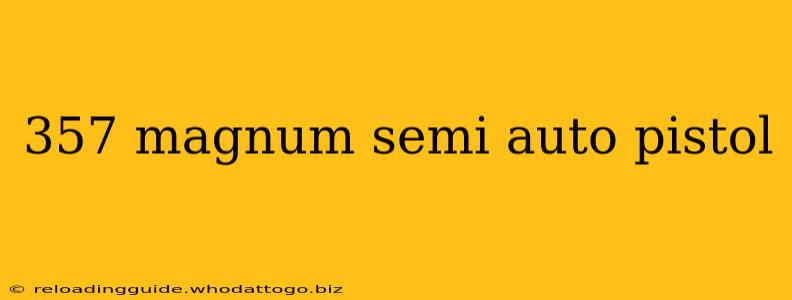The .357 Magnum cartridge, renowned for its stopping power, has traditionally been associated with revolvers. However, the desire for a semi-automatic pistol chambered in this potent round has led to innovative designs and a dedicated following. This article delves into the world of .357 Magnum semi-auto pistols, exploring their history, advantages, disadvantages, and notable examples. We'll also discuss the critical considerations for anyone contemplating owning one.
The Allure of the .357 Magnum Semi-Auto
The appeal of a .357 Magnum semi-automatic pistol is multifaceted. For many, it's the potent stopping power of the round, offering a significant advantage in self-defense situations. The higher velocity and heavier bullet weight compared to smaller calibers like 9mm or .40 S&W translate to greater energy transfer upon impact. This translates to a higher probability of incapacitating a threat.
Another key advantage is the versatility offered by the cartridge. Many .357 Magnum semi-autos are also capable of firing the less powerful .38 Special round, offering a more manageable recoil option for practice or less demanding situations. This dual-caliber capability extends the gun's usefulness significantly.
Challenges in Semi-Auto Design for .357 Magnum
Designing a reliable semi-automatic pistol chambered in .357 Magnum presents unique engineering challenges. The significant recoil generated by this powerful cartridge demands robust construction and innovative solutions to manage the forces involved. Early attempts often struggled with reliability, leading to malfunctions and jams. Modern advancements in materials and engineering have largely overcome these hurdles, leading to more reliable and durable firearms.
Notable Examples of .357 Magnum Semi-Auto Pistols
While not as numerous as 9mm or .40 S&W semi-autos, several manufacturers have successfully produced reliable .357 Magnum pistols. These models often incorporate features designed specifically to manage the increased recoil and ensure reliable cycling. Specific models and their features deserve a separate, in-depth analysis. However, researching specific models from established manufacturers is key to finding a reliable option.
Considerations for Potential Owners
Before purchasing a .357 Magnum semi-automatic pistol, several crucial factors require careful consideration:
Recoil Management:
The substantial recoil of the .357 Magnum necessitates proper training and a comfortable grip. Lack of proper training and experience could lead to injury or reduced accuracy.
Ammunition Cost:
.357 Magnum ammunition is generally more expensive than other calibers. This cost difference should be factored into the overall expense of ownership.
Maintenance:
The robust design required to handle the .357 Magnum's power might demand more frequent cleaning and maintenance compared to other semi-automatic pistols.
Concealed Carry Considerations:
While some compact models exist, carrying a .357 Magnum semi-auto concealed may be more challenging due to its size and weight compared to smaller-caliber options.
Conclusion: Power Demands Responsibility
The .357 Magnum semi-automatic pistol represents a powerful and versatile option for those seeking a high-stopping-power firearm. However, it's crucial to understand the inherent challenges and responsibilities associated with owning and operating such a weapon. Thorough research, professional training, and careful consideration of the factors outlined above are essential before making a purchase. Remember, responsible gun ownership involves rigorous training and a deep understanding of the firearm's capabilities and limitations. This ensures safety for both the owner and those around them.

